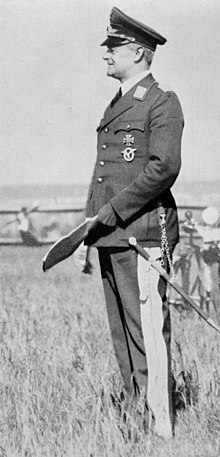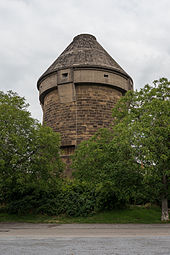Walther Wever
Walther Wever (born November 11, 1887 in Wilhelmsort , Bromberg district , † June 3, 1936 in Klotzsche ) was a German lieutenant general and chief of the general staff of the air force of the Wehrmacht .
Life
Wever was the grandson of the Prussian attorney general Georg Carl Wever and son of the later director of the German settlement bank Arnold Wever .
After his Abitur at the High School Steglitz stepped Wever 1905 in Swidnica in the Prussian army one. In 1906 he was promoted to lieutenant and in 1914 to first lieutenant. Wever was in the First World War, the end of December 1914 adjutant of the 21st Infantry Brigade and in June 1915, the captain promoted. Since July 1915 he worked in various general staffs of the troops. He had developed the concept of the so-called "flexible apron defense" with which the German troops long withstood the increasing pressure from the Allies. He was in the fall of 1917 in the Operations Department of the General Headquarters to Field Marshal Paul von Hindenburg added. He was personally present when Kaiser Wilhelm II decided to renounce the throne. He was also one of those who confirmed to the emperor that a trip to Dutch exile was necessary in order to avoid further bloodshed.
In 1919 he was commissioned by Hindenburg to edit the memoirs of Erich Ludendorff . He then moved to the General Staff of Group Command I in Berlin. Wever was one of the first to publicly advocate that the officers should now serve the democratically elected rulers of the Weimar Republic with the same dedication as they did before the Kaiser. In October 1921 he was the first non-Bavarian to be transferred to the General Staff of the 7th Division in Munich. From 1924 to 1927 he was head of a company. In 1926 he was promoted to major . From February 1927 he was a consultant in the Army Department of the Troops Office . He became battalion commander in 1929, lieutenant colonel in 1930 , head of the army training department in the troop office since 1932 and colonel in 1933 .
Since September 1, 1933, he took over the management of the air command office in the newly created Reich Aviation Ministry and was appointed major general in October 1934 . With the introduction of compulsory military service in March 1935, his function as Chief of the General Staff of the Air Force became evident. He became lieutenant general in April 1936.
As the first Chief of Staff of the Air Force, Wever was given the task of developing the principles of strategic as well as tactical air warfare based on Douhet's ideas and of laying down the technical specifications for the construction of modern aircraft. In order to underline the strategic importance of the Luftwaffe, in addition to Stukas , fighters and smaller bombers, he also had four-engine bombers developed, which he called Uralbomber ( Ju 89 and Do 19 ). According to recent research, however, he had this project stopped a few weeks before his death when it became increasingly clear to him that the regime was on a war path.
Together with Werner von Blomberg , Wever pushed through the opening of the Wehrmacht Academy at the Reichswehr Ministry in 1935 , in which selected employees were trained in strategy , war economics and politics in one-year courses . After his death and Blomberg's dismissal, it was closed again at Hermann Göring's instigation .
After Wever, on June 6, 1936, the “General Wever Squadron”, to which the Gotha, 253 and 4 combat squadrons belonged, the “General Wever barracks” in Hanover , Munich (today: Bayern barracks ), in Potsdam-Eiche and in Rheine as well as a high bunker in Heilbronn . The tower as well as several streets bore or still bear his name.
In 1920 he married Hertha Suadicani, daughter of the secret government and senior building officer Waldemar Suadicani , who built several Berlin train stations and the Berlin light rail system , and his wife Alice, née. Payne. His two sons Günther Wever (1920–2004) and Walther W. Wever (1923–1945) were Air Force officers in World War II . His son Walther fell as a fighter pilot .
Wevers death
Wever had a Heinkel He 70 service machine available. Although he could have had his own pilot, he preferred to take the wheel himself. On June 3, 1936, he and a flight engineer wanted to fly from Dresden to Berlin in order to be there in time for the state funeral of the former infantry general and NSDAP politician Karl Litzmann , who had died at the end of May. The departure took place with a time delay (Wever had previously given a lecture in Dresden that had lasted longer than planned) and with great hectic pace. The necessary checks on the He 70 were not carried out before take-off, and the take-off was very hasty.
Shortly after take-off, the aircraft's left wing lowered and the aircraft turned on its back. The aircraft crashed uncontrollably into a nearby field shortly after the runway. Since the machine hit the supine position (so the cockpit touched the ground first), Wever and his companion had no chance of survival; they died instantly on impact. A subsequent examination of the debris showed that the locking pins that fixed the ailerons on the ground had not been removed before take-off. Wever therefore had no way of stabilizing the machine in the air around its longitudinal axis. This tragic omission, which can very probably be traced back to the hasty departure, had no consequences for the maintenance crews on the ground, as they had only complied with Weber's orders for a quick start.
The funeral on June 6, 1936 at the Kleinmachnower Waldfriedhof was lavishly staged; Wever's widow was led by Goering.
Context: Air Force Armament
The Luftwaffe has been massively upgraded since 1933 .
Despite the difficulties that the rapid construction brought with it, the years 1933 to 1936 were characterized by effective cooperation between the leading men in the Reich Aviation Ministry; Overflowing with offices, Göring largely gave his employees Erhard Milch , Wilhelm Wimmer and Walther Wever a free hand. The air armament of these years took into account (more than with the army and navy) economic factors (costs, production capacities, etc.) of the armament. The main armament was tactical bombers; In addition, the importance of the strategic deployment options was recognized (Wever, as the head of the air command office, declared in his 1935 "Air Warfare Regulations" that the tasks of the Air Force on the offensive against the "fighting power of the enemy, i.e. against the enemy air force and then against the power sources of the enemy army ”and therefore had guidelines drawn up for the further development of a strategic bomber).
After Wever's death, Goering appointed Lieutenant General Albert Kesselring as his successor. At the same time, the General Staff was now directly subordinate to Goering. This effectively ended Milk's position as Deputy Mayor of the Air Force in day-to-day business; in this function he only stepped in for Goering when there was a real need. From 1936 Göring became more involved in official business and began playing off the three highest air force officers against each other.
Awards
- Iron Cross (1914) 2nd and 1st class
- Knight's Cross of the Royal House Order of Hohenzollern with swords
- Bavarian Order of Military Merit IV class with swords
- Knight's Cross 1st Class of the Order of Albrecht with Swords
- Knight's Cross 1st Class of the Order of Frederick
- Mecklenburg Military Merit Cross II. Class
- Mecklenburg Cross for distinction in the Second Class of War
- Braunschweig War Merit Cross, 2nd and 1st class
- Knight's Cross 2nd class of the Saxon-Ernestine House Order
- Austrian Military Merit Cross III. Class with the war decoration
- Iron crescent
- Pilot and observer badge in gold with diamonds on November 11, 1935
Honors
In Berlin there is a Weverstraße in Wilhelmstadt , a district of Spandau. In Hanover, the Greens and the SPD are about to rename the “General-Wever-Straße” (as of August 2019).
Others
Josef Kammhuber (1896–1986) was part of General Walther Wever's staff for the establishment of a strategic bomber command . After the war, Kammhuber became the air force inspector of the Bundeswehr.
literature
- Dermot Bradley : Tradition for the Air Force: Lieutenant General Walther Wever (1887–1936). Mars Yearbook for Defense Policy and Military Affairs, Volume 3/4. Osnabrück 1997.
- James S. Corum: The Luftwaffe: Creating the Operational Air War, 1918-1940. Marlowe & Company, 1997.
Web links
- Short biography. In: Officials of National Socialist Reich Ministries.
Individual evidence
- ↑ Arnold Wever's grave .
- ^ Mason, Herbert M .: The Air Force 1918–1945. Build up, rise, fail. Paul Neff Publishing House. Vienna 1973, p. 197.
- ↑ Mason: Die Luftwaffe , p. 198.
- ↑ Rolf Schabel: The illusion of miracle weapons. Oldenbourg Verlag, Munich 1994, ISBN 3-486-55965-6 , p. 79.
- ↑ Guido Knopp , Friederike Dreykluft: Hitler's warriors . Goldmann-Verlag, Munich 2000, ISBN 3-442-15045-0 , p. 337.
- ↑ see also Ernst Stilla: The air force in the fight for air supremacy. Decisive influencing factors in the defeat of the Luftwaffe in the defensive battle in the West and over Germany in the Second World War with special consideration of the factors “air armament”, “research and development” and “human resources”. Dissertation, 2005, pp. 38–46, Structural difficulties and the negative influence of Göring on the organization and ability to act of the air force command (PDF)
- ↑ a b c d e f g h i j k Ranking list of the German Reichsheeres. Mittler & Sohn, Berlin, p. 119.
- ^ Jörg Nimmergut : German medals and decorations until 1945. Volume 4. Württemberg II - German Empire. Central Office for Scientific Order Studies, Munich 2001, ISBN 3-00-001396-2 , p. 2441.
| personal data | |
|---|---|
| SURNAME | Wever, Walther |
| BRIEF DESCRIPTION | German Lieutenant General and Chief of the Air Force General Staff |
| DATE OF BIRTH | November 11, 1887 |
| PLACE OF BIRTH | Wilhelmsort |
| DATE OF DEATH | June 3, 1936 |
| Place of death | Dresden - Klotzsche |



